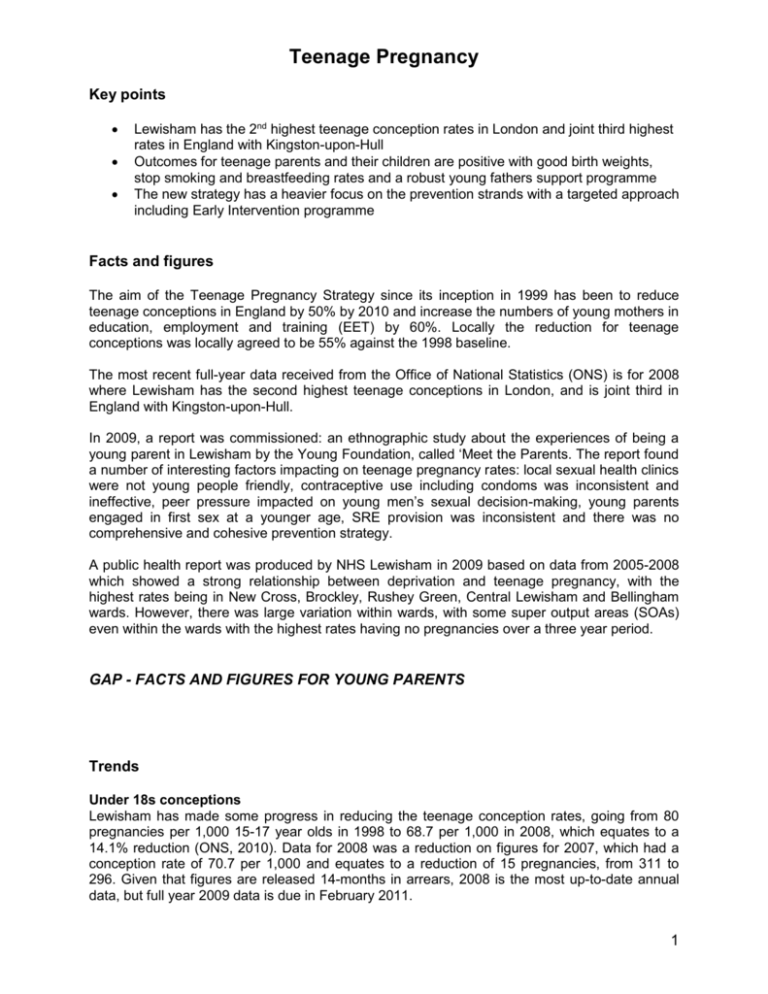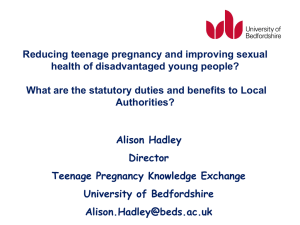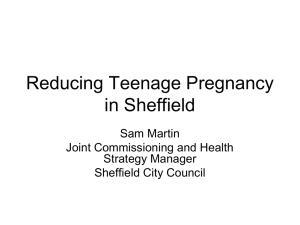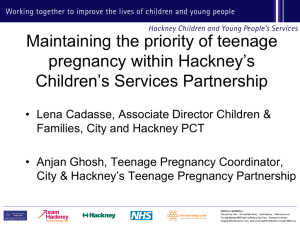
Teenage Pregnancy
Key points
Lewisham has the 2nd highest teenage conception rates in London and joint third highest
rates in England with Kingston-upon-Hull
Outcomes for teenage parents and their children are positive with good birth weights,
stop smoking and breastfeeding rates and a robust young fathers support programme
The new strategy has a heavier focus on the prevention strands with a targeted approach
including Early Intervention programme
Facts and figures
The aim of the Teenage Pregnancy Strategy since its inception in 1999 has been to reduce
teenage conceptions in England by 50% by 2010 and increase the numbers of young mothers in
education, employment and training (EET) by 60%. Locally the reduction for teenage
conceptions was locally agreed to be 55% against the 1998 baseline.
The most recent full-year data received from the Office of National Statistics (ONS) is for 2008
where Lewisham has the second highest teenage conceptions in London, and is joint third in
England with Kingston-upon-Hull.
In 2009, a report was commissioned: an ethnographic study about the experiences of being a
young parent in Lewisham by the Young Foundation, called ‘Meet the Parents. The report found
a number of interesting factors impacting on teenage pregnancy rates: local sexual health clinics
were not young people friendly, contraceptive use including condoms was inconsistent and
ineffective, peer pressure impacted on young men’s sexual decision-making, young parents
engaged in first sex at a younger age, SRE provision was inconsistent and there was no
comprehensive and cohesive prevention strategy.
A public health report was produced by NHS Lewisham in 2009 based on data from 2005-2008
which showed a strong relationship between deprivation and teenage pregnancy, with the
highest rates being in New Cross, Brockley, Rushey Green, Central Lewisham and Bellingham
wards. However, there was large variation within wards, with some super output areas (SOAs)
even within the wards with the highest rates having no pregnancies over a three year period.
GAP - FACTS AND FIGURES FOR YOUNG PARENTS
Trends
Under 18s conceptions
Lewisham has made some progress in reducing the teenage conception rates, going from 80
pregnancies per 1,000 15-17 year olds in 1998 to 68.7 per 1,000 in 2008, which equates to a
14.1% reduction (ONS, 2010). Data for 2008 was a reduction on figures for 2007, which had a
conception rate of 70.7 per 1,000 and equates to a reduction of 15 pregnancies, from 311 to
296. Given that figures are released 14-months in arrears, 2008 is the most up-to-date annual
data, but full year 2009 data is due in February 2011.
1
Historically figures have not been on a consistent downward trend, as seen in Figure 1, where
the dark blue line shows the ongoing rolling average, which has peaked and troughed without a
clear pattern since the beginning of the strategy.
100
90
Under 18 conception rate per 1000
80
70
Quarterly rate
60
Rolling average
50
40
30
20
0
March
June
Sept
Dec
March
June
Sept
Dec
March
June
Sept
Dec
March
June
Sept
Dec
March
June
Sept
Dec
March
June
Sept
Dec
March
June
Sept
Dec
March
June
Sept
Dec
March
June
Sept
Dec
March
June
Sept
Dec
March
June
Sept
Dec
March
June
10
1998
1999
2000
2001
2002
2003
2004
2005
2006
2007
2008
2009
Quarter & Year
Figure 1: Quarterly Rates in Lewisham Q1 1998 – Q2 2009, ONS
However, first data releases for 2009 show a rate of 56.3 per 1,000 for Q1 and 65.4 for Q2,
which has given the lowest rolling quarterly average since 2001 and the first occurrence of two
low successive quarters at the beginning of any year since 1998. In addition, these figures place
Lewisham as the 5th highest reduction by against 1998 figures in London with 18.7% against the
baseline, but we will need to wait until February 2011 for full data to ascertain progress in it’s
entirety.
When comparing Lewisham’s progression to both London and England, our reduction has been
greater than both national and regional averages, see Figure 2.
90
Under 18 conception rate per 1000
80
Lewisham
70
60
London
50
England
40
30
20
0
March
June
Sept
Dec
March
June
Sept
Dec
March
June
Sept
Dec
March
June
Sept
Dec
March
June
Sept
Dec
March
June
Sept
Dec
March
June
Sept
Dec
March
June
Sept
Dec
March
June
Sept
Dec
March
June
Sept
Dec
March
June
Sept
Dec
March
June
10
1998
1999
2000
2001
2002
2003
2004
2005
2006
2007
2008
2009
Quarter & Year
Figure 2: Lewisham, London and England comparisons, ONS
2
However, from 2008 data (ONS, 2010) one of our statistical neighbours, Southwark has made a
22% reduction against their 1998 figures. In addition, other local areas such as Bromley and
Bexley, have had increases in their conception rates by over 20% from their 2008 data when
compared to initial baseline figures from 1998.
Abortion data
Recently published ONS data (ONS, 2010) for Quarter 1 of 2010 shows that Lewisham has 5
abortions per 1,000 population. When compared to the same time period in previous years, this
shows a reduction, as Q1 2008 shows 12 and Q1 2009 shows 8 abortions to this age group. In
terms of numbers, Q1 2010 had a total of 23 terminations when compared to 2009 and 2008
with 36 and 51 terminations respectively.
Repeat abortions in the same time period show 44% as having 1 or more pervious abortions for
Q1 2010, compared to 46% for Q1 2009 and 43% for Q1 2008. Data for full year terminations
shows 2009 with 57% a slight reduction on 2008 figure of 59% (ONS, 2009).
GAP - OUTCOMES FOR TEENAGE PARENTS AND THEIR CHILDREN
Targets
The government set targets within the national Teenage Pregnancy Strategy (1999) to reduce
teenage conception whereby Lewisham was given the stretch target of 55% reduction against
the 1998 baseline and this has been referred to as the National Indicator (NI) 112. Other local
targets include:
LPZ 140 Under 18 Conceptions (rates per 1,000 f U18)
LPZ 141 Under 16 Conceptions (rates per 1,000 f U16)
LPI198 Conceptions women 15-17 per 1,000 LBL (Quarterly)
The target expressed in the local Children and Young People’s plan is: Priority BH3: Further
reduce teenage conceptions and reduce the rate of sexually transmitted infections (STIs) and
the NHS Lewisham World Class Commissioning Outcome is to ‘reduce the number of under-18
conceptions to 49 per 1,000 by 2014’.
GAP - INCREASE IN TEENAGE PARENTS IN EET
Performance
Current performance of teenage pregnancy has rendered a 14.1% reduction in the 1998
baseline figures from 2008 full year data and current figures for quarter 1 and 2 of 2009 show an
18.7% reduction. It is expected, but not guaranteed therefore that further 2009 data will solidify
this downward trend.
Local views
The re-alignment of Lewisham’s Teenage Pregnancy Strategy was informed by the Teenage
Pregnancy Awayday which took place in October 2009 with local stakeholders, evidence from
3
the Teenage Pregnancy Self Assessment Toolkit (previously used by local areas to determine
gaps and review progress), meetings with key agencies including the PCT, voluntary sector and
statutory partners and two pieces of research as previously mentioned above.
A prioritisation event held in autumn 2009 with Lewisham residents, identified teenage
pregnancy as the fifth most important issue to tackle in the borough.
Consultation with the Young Advisors in November 2009 revealed that STIs and teenage
pregnancy were two health issues amongst the top 6 identified as detrimentally affecting young
people and their peers.
National and local strategies
There are a number of national and local agendas to which relate to teenage pregnancy:
National Teenage Pregnancy Strategy
Sexual Health and HIV Strategy
Every Child Matters
21st Century Schools
Healthy Schools and Enhanced Healthy Schools
Healthy FE
Going All the Way – Sexual Health in FE Colleges
You’re Welcome Quality Criteria
Children and Young People’s Plan
Current Activity and Services
The new Teenage Pregnancy Action Plan for 2010-2012 includes a range of services and
initiatives being provided to the community, staff and young people to reduce teenage
conception and increase support to young parents. A range of services are engaged in providing
this work from the voluntary sector, youth service, substance misuse providers, community
pharmacy and primary care. The plan includes: engaging with a young people lead social
enterprise to develop a marketing campaign, providing Early Intervention support to young
people deemed vulnerable to teenage pregnancy as identified through referral forms and data
analysis, expanding LARC insertions to under 19s, participating in the pan-London c-card
scheme, supporting educational settings with SRE providing holistic workforce development to
staff across the borough.
What are the key inequalities?
The public health analysis from 2009 found that young black women were more likely to become
pregnant at a rate of 70 per 1,000 compared to 42 per 1,000 of their white counterparts.
Similarly, young black women were more likely to have an abortion, 47 per 1,000 compared to
22 per 1,000 and twice as likely to have used pharmacies to obtain free EHC with 400 per 1,000
compared to 200 per 1,000. The highest number of EHC items were dispensed to residents of
SE6 (Catford) but this may reflect the location of pharmacies rather than need.
Recent data analysis on teenage conception data for 2005-2007 showed the Bellingham has the
most conceptions during that period when compared to wards with similar demographic and
deprivation scores e.g. Evelyn ward. Although this shows the link between deprivation and
4
teenage pregnancy, it could be interpreted that the greater amount of youth provisions within
Evelyn and New Cross regions have had an impact.
Figure 3: Numbers of teenage conceptions per ward
When comparing Lewisham’s teenage conception rates with neighbouring boroughs, it suggests
that 4 out of 6 South-East London boroughs have a particular challenge with this issue, given
Lambeth, Lewisham, Southwark and Greenwich are the top 4 highest rates in the region. By
comparison, Bromley and Bexley, although their rates are lower, have had a significant increase
against their 1998 baselines from 1998 data.
Gaps in knowledge and information
In summer 2010, the governance for teenage pregnancy in Lewisham shifted to include a three
tiered approach. The IYSS Board is the overarching group coordinating and monitoring the
5
progress of the work and a new senior level group has been created underneath this called the
Teenage Pregnancy Taskgroup which is specifically to report the challenges and barriers to
meeting the targets set within the Action Plan. Four sub-groups have also been set up for
operational staff to report and discuss progress against their actions. The Promotion and
Marketing sub-group is part of the IYSS structure but will report on teenage pregnancy as well
as other aspects of the department’s work.
CYPSPB
JCG
IYSS Board
Teenage
Pregnancy
Task Group
SRE
Access
Support
IYSS
Promotion,
Marketing
& Communication
Figure 4: Teenage Pregnancy Governance Structure, 2010
Given the above re-development of the governance structure, the sharing of partnership
knowledge will be taking place at sub-group level, during the Taskgroup and also within the
broader IYSS board. It is therefore expected that these groups will enable the collective sharing
of skills and knowledge.
All four of the borough’s sexual health services in Rushey Green, Downham, New Cross and
Sydenham wards will be evaluated through the national You’re Welcome program in partnership
between public health, the local authority and young people trained to be mystery shoppers.
Current plans include an annual online consultation events with parents, the community and
young people to establish satisfaction with the work being provided by a range of agencies, to
generate suggestions and provide opportunities for feedback.
The new Early Intervention approach to teenage pregnancy prevention is currently operating
whereby local databases are analysed to identify young people matching 3 or more of the
6
national teenage pregnancy risk factors. A referral process is also in place for professionals to
refer young people into the service who meet those criteria. Some risk factors such as the health
related ones e.g. repeat abortion, cannot generate individual names, hence the advantage for
termination services, primary care and other health providers to refer young people into the
service. This approach was developed as a direct method to engage with young people most at
risk of early pregnancy and parenthood and attempting to provide a service to address
professionals predictions about young people’s future. One member of the teenage pregnancy
team in Local Authority, had for approximately 18 months, provided 1:1 support to 42 young
women deemed at risk, whereby only 1 became pregnancy and chose to terminate. A similar
model has also been used by Stoke-on-Trent which resulted in a 14% reduction in teenage
pregnancy rates between 2007 and 2008.
Partnership working is integral to the borough’s approach to teenage pregnancy and the above
governance structure includes voluntary sector representation. Collaborative working is good,
particularly between the Council and Public Health department of the local PCT. The strategic
lead for teenage pregnancy sits on a range of groups including: Substance misuse expert group,
Sexual Health Strategy Group, NEET Strategy Group, Sexual Health in FE Colleges and
Violence Against Women, Healthy Schools Quality Assurance Group and Girls Strategy Group.
Attendance at these meetings enables liaison with a range of partners from primary care,
Connexions, Community Safety, Youth Offending, Victim Support, housing, education, schools
and other voluntary agencies.
In addition, recently obtained publicity materials such as posters and leaflets from Brook, the fpa,
the Home Office on risks of pregnancy following a birth, contraceptive methods including LARC,
condom use, homophobia, teen relationship violence and sexually transmitted infections (STIs)
have been sent to leisure centres, FE colleges, schools, local libraries, social services, youth
offending, Sure Start Plus, housing providers e.g. Centrepoint and youth services such as youth
clubs and adventure playgrounds.
There have been recent re-distributions regarding staff and financial resources to provide a
targeted approach to teenage pregnancy prevention as per the above. In addition, the
partnership are also investigating the opportunity to provide emergency hormonal contraception
(EHC) in community pharmacies within teenage pregnancy hotspot areas. In addition, Teens
and Toddlers had been commissioned in the borough but as activity reduced overtime, it was
decided that although the evidence base was strong, the logistics of the programme was not
reaching the most at-risk young people, nor progressing at the desired rate. One of the sexual
health clinics which operated on a Saturday with a low-turn out was de-commissioned as it was
not cost-effective.
The recent shift in Early Intervention approach to prevention has come about following the
success in Stoke-on-Trent as above and the local success over an 18-month period. We have
also engaged heavily in local LARC promotion with the sexual and reproductive services making
use of their publicity budget to promote LARC methods to young people using local female users
on their posters. Use of the pan-London LARC leaflets has been widespread. A new focus on
workforce development for local staff follows the national best-practice advice.
The development of the nationally researched Family Nurse Partnership within the borough is
expecting the outcomes experienced in other UK regions and in the USA for the past 20 years.
The above approach is currently identifying young people across the borough who are deemed
at risk of pregnancy and has been promoted to professionals across the PCT, local authority,
education providers and voluntary sector.
YOUNG PARENTS?
7
What are the risks in not developing our targets?
The risk log for the teenage pregnancy programme is currently being developed including
remedial action. This will be available in November 2010.
Is what we are doing working?
From the Meet the Parents report (2009) we are aware that the young fathers’ program is
appreciated by the service users as it was sited as excellent support.
Our work with young mothers is seen to be excellent considering the good uptake of
CaretoLearn CHECK THIS, the update of breastfeeding, birth weights and stop smoking rates.
Current data for the first two quarters of 2009 suggest that teenage conception rates are firmly
on a downward trend which is a positive outcome. The Early Intervention work undertaken by
the local authority to date has been successful.
The You’re Welcome toolkits and accompanying audit material will provide an understanding of
the performance improvements.
PERFORMANCE OUTCOMES?
PERFORMANCE TREND – LARC?
EVALUATION OF PROJECT ACTIVITY – FNP?
What is coming up on the horizon?
We are aware from CCIS data from Connexions that the young people’s population is increasing
and we are keeping this in mind when developing our Early Intervention approach and others.
YOUNG PARENTS? Changes to CaretoLearn?
What should we be doing next?
We have prioritised 4 key areas to develop:
1. Targeted work in geographical areas – the teenage pregnancy lead at the local authority
is meeting with the Bellingham Health Forum to establish needs
2. Voluntary and community sector involvement needs to improve – the Voluntary Action
Lewisham role Children and Young People’s Development Officer is currently being
recruited to and once they are in post the teenage pregnancy team and/or others will be
engaging with the Youth Forum and recruiting more representatives to the Teenage
Pregnancy governance groups.
3. Development of local SRE and SRH requirements in schools – the Associate Director
Children & Young People’s Services is currently undertaking a commissioning review
about the provisions within education in the borough. This is to ensure continuity and
8
consistency between the school nursing service and the Sexual Health Outreach team
who are part of the clinical team within the PCT.
4. SRH provision for LAC - The Associate Director is also undertaking an investigation into
how to provide a more targeted service for looked-after children through the two LAC
nurses to increase use of contraceptives, condoms and particularly LARC methods.
5. You’re Welcome accreditation for sexual health clinics – this is underway and it is
expected that by the end of 2010 all 4 clinics will be awarded ‘young people friendly’
status.
9






